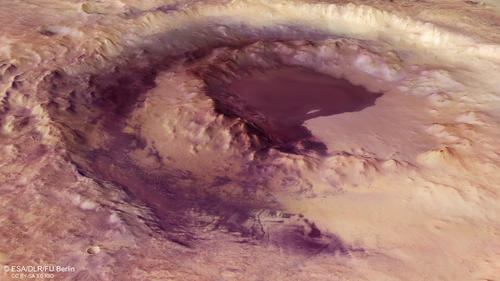The Martian impact crater Lowell
Lowell Crater is named after the US mathematician, astronomer and writer Percival Lowell. A member of the Boston elite, in 1894 he founded the Lowell Observatory in Flagstaff, Arizona, for purposes including research into the planet Mars. Inspired by Giovanni Schiaparelli’s theories about canali (canals) on Mars, Lowell advanced the idea that these were drainage channels built by an intelligent civilisation. In 1905 he predicted the existence of a 'Planet X' beyond the orbit of Neptune. His theory proved to be correct, although Pluto was only discovered in 1930, some years after his death.
The impact crater, which is between 3.7 and 3.9 billion years old, is located in the Aonia Terra region of the southern Martian highlands. Over the course of millions of years, Lowell Crater has been altered by erosion and filled with sediments that have levelled the crater floor. Dark sand dunes, gullies and channels created by water run-off are visible along the inner rim of the crater. The impact ejecta are distributed radially over an area of the crater’s surroundings that extends for more than one crater diameter. There, it forms a star-shaped layer of debris that remains clearly visible in some places even today.
Special about Lowell crater is a ring of mountains 90 kilometers in diameter in the crater center. Similar peak-ring impact craters have been observed also on Earth, Venus, Mercury, and the Moon. In general, central peaks and peak-rings form by gravity-driven collapse and uplift of the floor following crater excavation. The collapse of craters of a certain diameter can give rise to a complex interior structure with flat floors, central peaks, wall terraces, and internal rings, whereas smaller impact craters have a simple bowl shape. The transition diameter of so-called simple to complex craters depends on the gravity of the planet, as well as on the target material strength. When a complex crater reaches a diameter of more than ~45 kilometers (Mars), or ~25 kilometers (Earth), the central uplift can create a ring of irregular mountain peaks in the crater center.
The investigation and simulations of data obtained from drilling expeditions of the 200-kilometer Chicxulub impact crater on peninsula Yucatán (Mexico) attributed peak-ring formation to the collapse of uplifted oversized, unstable central peaks. Consequently, the rocks forming peak rings originate from the deep subsurface of the impact site. The Chicxulub impact 66 million years ago is linked to the mass extinction of the dinosaurs.
